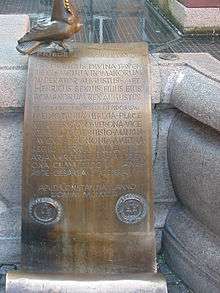Peace of Constance
The Peace of Constance (25 June 1183) was a privilege granted by Frederick I, Holy Roman Emperor, and his son and co-ruler, Henry VI, King of the Romans, to the members of the Lombard League to end the state of rebellion (war) that been ongoing since 1167. It was a permanent peace that superseded the six-year truce imposed by the Treaty of Venice (22 July 1177).[1]

With the expiration of the truce approaching, negotiations between the emperor and the league were begun in early 1183. There were proposals and counter-proposals, a separate settlement of the disputed status of Alessandria and a preliminary agreement signed at Piacenza. The treaty of Piacenza formed the basis for the final peace, which was issued as an imperial privilege because formally the emperor could not sign a treaty with his subjects.[1]
Terms
The agreement confirmed the 1177 treaty of Venice. The cities in the Kingdom of Italy retained several regalia of local jurisdiction over their territories and had the freedom to elect their own councils and to enact their own legislation, as well as to keep their Lombard League alliance. On the other hand, they were required to swear an oath of fealty to the Holy Roman Emperor and their consuls had to be invested directly by him.[2] Imperial judges had the prerogative to judge appeals and some districts in Italy were placed under direct Imperial administration. The cities also retained civil and criminal jurisdiction[3] while the appellate jurisdiction was in the imperial hands.[3] The consuls were only allowed to render final verdicts in crimes that involve sums of less than twenty-five pounds of gold.[2]
A commentary about the agreement by Baldo degli Ubaldi published in his Commentaria in usus feudorum identified the capability attributed to the emperor to break aspects of it because his oath was considered temporary.[4] However, there was no attempt to infringe the conditions of the compact on the part of the crown during the 67-year reign of the house of Hohenstaufen.[5]
The cities stopped fulfilling their obligations during the long struggle for the Imperial crown that followed the death of Frederick's son Emperor Henry VI in 1197, and the Peace of Constance was at the centre of the new conflict fought between the so-called second Lombard League and Emperor Frederick II between 1226 and 1250. It was celebrated for the rest of the Middle Ages and beyond as the only Imperial recognition of the autonomy of a large group of Italian cities.
Text
- Latin text of the Peace of Constance in MGH, Diplomata, X.iv (Hanover, 1990), pp. 71–77
- Partial English translation by Frances Andrews in Katherine L. Jansen, Joanna Drell and Frances Andrews (eds.), Medieval Italy: Texts in Translation (University of Pennsylvania Press, 2009), pp. 61–63. JSTOR j.ctt3fhhzb.22 doi:10.9783/9780812206067.61
Notes
- Freed 2016, p. 422–427.
- Witt, Ronald (2012). The Two Latin Cultures and the Foundation of Renaissance Humanism in Medieval Italy. Cambridge: Cambridge University Press. p. 234. ISBN 9780521764742.
- Kleinhenz, Christopher (2017). Medieval Italy: An Encyclopedia. Vol. 1. Oxford: Routledge. p. 249. ISBN 9781138063266.
- Law, John (2016-12-05). Communes and Despots in Medieval and Renaissance Italy. London: Routledge. ISBN 9781351950350.
- de Sismondi, Jean Charles Leonard (2008). A History of the Italian Republics. Cabin John, Maryland: Wildside Press LLC. p. 49. ISBN 9781434460646.
Sources
- Freed, John (2016). Frederick Barbarossa: The Prince and the Myth. New Haven, CT: Yale University Press. ISBN 978-0-300-122763.CS1 maint: ref=harv (link)
- Raccagni, Gianluca (2008). "Il diritto pubblico, la pace di costanza e i «libri iurium» dei comuni lombardi". In D. Quaglioni; G. Dilcher (eds.). Gli inizi del diritto pubblico, 2: Da Federico I a Federico II. Bologna–Berlin. pp. 309–340.CS1 maint: ref=harv (link)
- Raccagni, Gianluca (2010). The Lombard League, 1164–1225. Oxford University Press.CS1 maint: ref=harv (link)
- Raccagni, Gianluca (2013). "The Teaching of Rhetoric and the Magna Carta of the Lombard Cities: The Peace of Constance, the Empire and the Papacy in the Works of Guido Faba and His Leading Contemporary Colleagues". Journal of Medieval History. 39 (1): 61–79. doi:10.1080/03044181.2012.745446.CS1 maint: ref=harv (link)
- Raccagni, Gianluca (2016). "When the Emperor Submitted to his Rebellious Subjects: A Neglected and Innovative Legal Account of the Peace of Constance, 1183" (PDF). The English Historical Review. 131 (550): 519–539. doi:10.1093/ehr/cew173.CS1 maint: ref=harv (link)